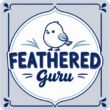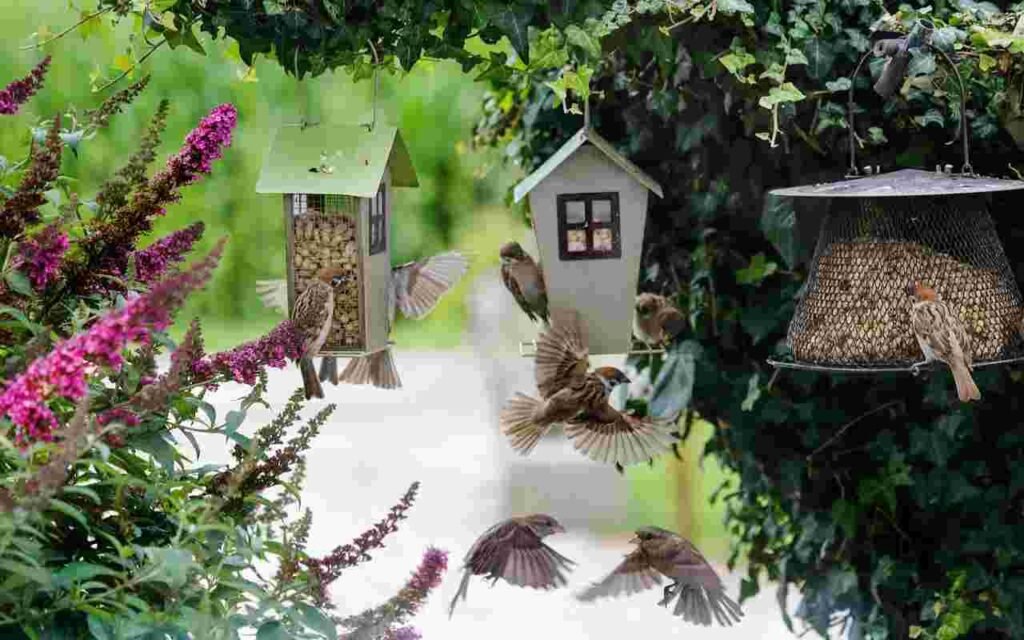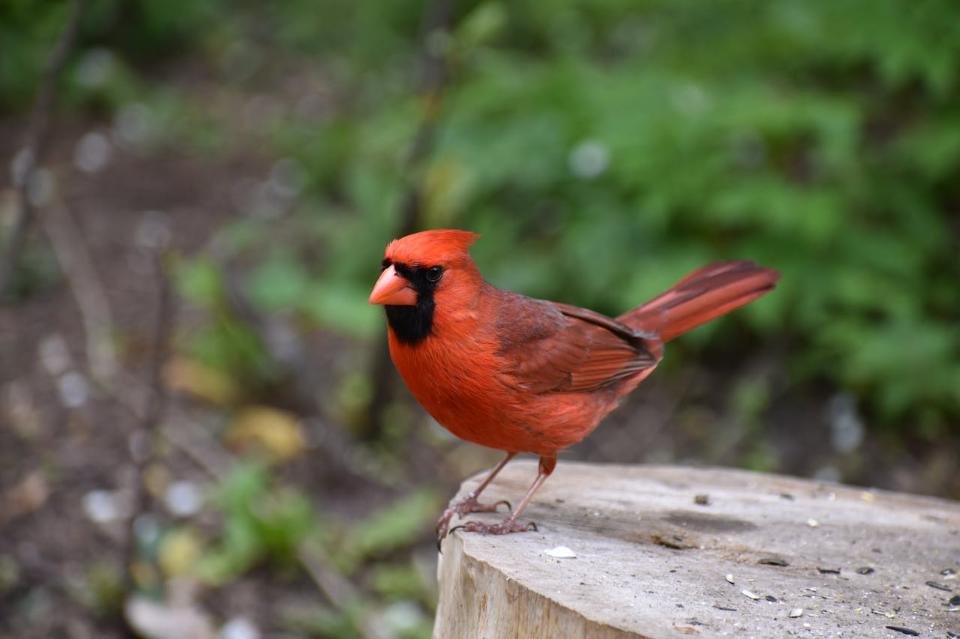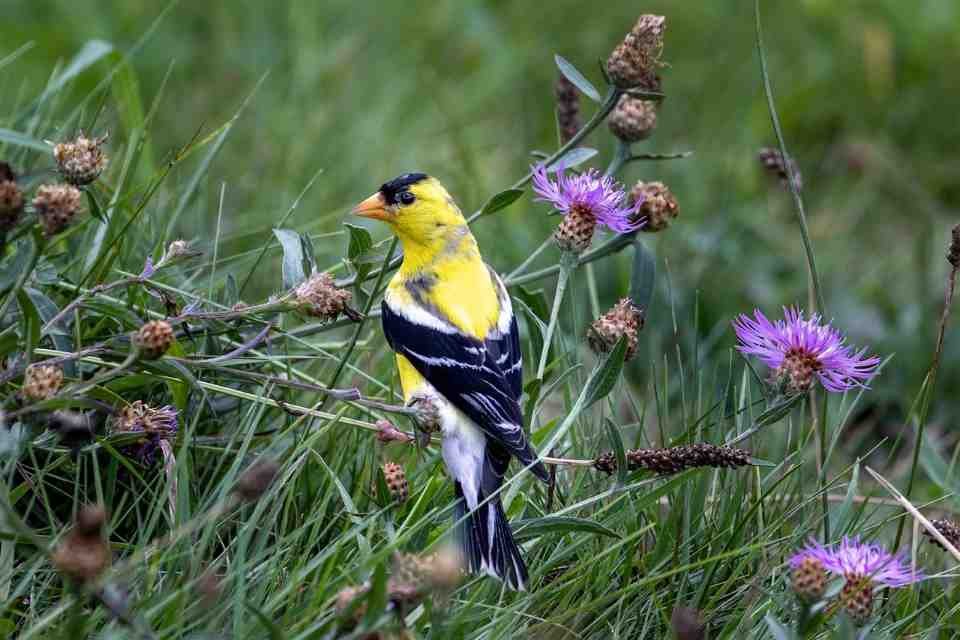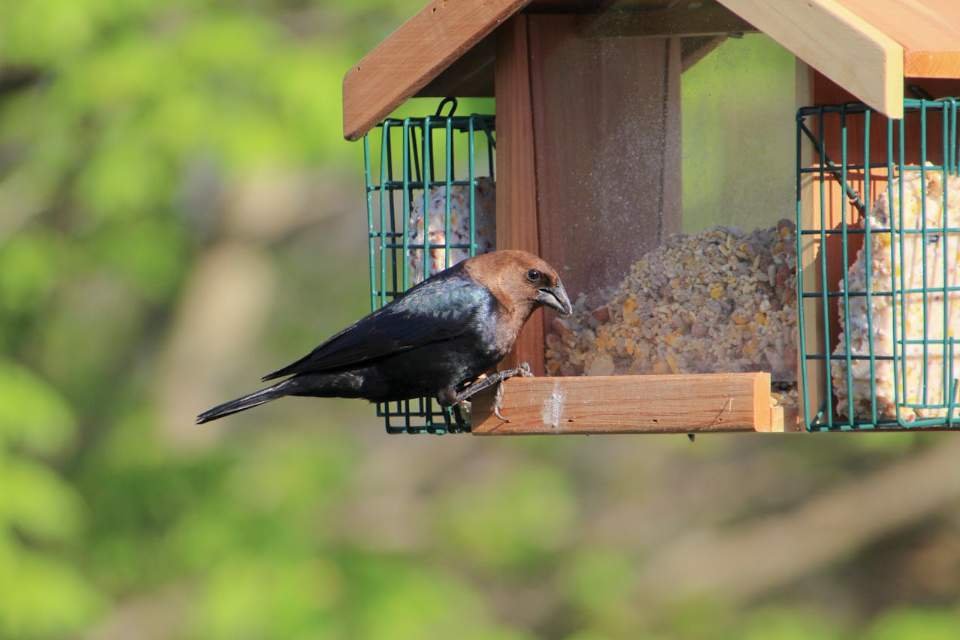Picture this: you’re sipping your morning coffee, and suddenly your backyard transforms into a bustling avian highway. Cardinals flash red against green foliage, chickadees perform their acrobatic feeding routines, and maybe, just maybe, you spot that elusive bluebird you’ve been hoping for.
Sound too good to be true? Trust me, it’s not. With the right bird friendly garden design, you can turn an ordinary yard into a bird magnet. I’ve been doing it for years, and I’m here to spill all the secrets that’ll have your neighbors wondering why all the birds love your place more than theirs 🙂 .
Why Birds Matter More Than You Think
Before we jump into the fun stuff, let’s talk about why attracting birds isn’t just about having pretty morning entertainment. These feathered friends are nature’s pest control squad, gobbling up thousands of insects that would otherwise munch on your prized tomatoes. Ever watched a wren hunt for bugs? It’s like having a tiny, tireless gardener working for free.
Birds also pollinate plants, spread seeds, and create that magical ecosystem balance we’re all chasing. According to the Cornell Lab of Ornithology, birds play a crucial role in seed dispersal and pollination, helping maintain healthy ecosystems. Plus, there’s something deeply satisfying about knowing you’ve created a space where wildlife thrives.
IMO, a garden without birds feels a bit like a party without music, technically functional, but missing that special spark.
The Foundation: Native Plants Are Your Secret Weapon
Here’s where most people mess up: they plant what looks pretty instead of what actually works. I learned this the hard way after spending a fortune on exotic shrubs that birds completely ignored. Want to know what finally turned things around? Native plants.
Why Native Species Rule the Roost
Native plants evolved alongside local bird populations, creating perfect partnerships that imported species simply can’t match. These plants produce the right seeds at the right time, attract the insects birds need for protein, and provide materials for nest building. As noted by the Audubon Society, planting native species supports local bird populations by providing the right food, nesting materials, and habitat.
Some powerhouse native options include:
• Elderberry – produces clusters of berries that over 40 bird species devour
• Oak trees – support more than 500 species of caterpillars (bird candy!)
• Sunflowers – goldfinches go absolutely nuts for these seeds
• Serviceberry – early bloomer that feeds birds when other food is scarce
The best part? Native plants require less water, fewer pesticides, and minimal fussing once established. Your wallet and the environment will thank you.
Timing Your Plantings
Strategic planting means year-round bird buffet. I arrange my garden so something’s always producing food. Spring brings berry-producing shrubs, summer offers seed heads and nesting materials, fall provides migrating birds with fuel, and winter keeps resident birds fed when times get tough.
Water Features: The Ultimate Bird Magnet
If plants are the foundation, water is the irresistible invitation. I’ve seen birds ignore perfectly good feeders to splash around in a simple birdbath. Water attracts species that might never visit your seed stations, expanding your backyard bird diversity dramatically. According to the National Wildlife Federation, providing water sources in your yard significantly increases bird species diversity.
Beyond the Basic Birdbath
Sure, traditional birdbaths work, but why stop there? Moving water creates sounds that travel much further than still water, essentially sending out a “hey birds, party over here” signal.
Here are some water features that consistently deliver results:
• Dripping fountains – the sound drives birds wild
• Shallow ponds with graduated depths (1-3 inches max)
• Recirculating streams – even tiny ones work
• Misters during hot weather – hummingbirds especially love these
Pro tip: position water sources about 3-4 feet from dense shrubs. This gives birds quick escape routes while preventing cats from ambushing drinking birds. Trust me, I’ve seen too many close calls!
Maintenance Reality Check
Let’s be honest about water feature upkeep. You’ll need to clean them regularly, especially during algae season. I change my birdbath water every 2-3 days and scrub it weekly with a stiff brush. No chemicals needed, birds are sensitive to residues that won’t bother humans.
Strategic Landscaping: Creating Bird Highways
Think about how birds move through space. They don’t just materialize at your feeder, they travel along corridors of trees and shrubs that provide safety and food. Smart landscaping creates these natural highways right through your property.
Think about how birds move through space. They don’t just materialize at your feeder; they travel along corridors of trees and shrubs that provide safety and food. Smart landscaping creates these natural highways right through your property. According to the University of Illinois Extension, layered plantings can help create safe travel corridors and shelter for birds.
The Three-Layer Approach
Professional landscapers use this technique, and it works brilliantly for bird-friendly gardens:
Canopy Layer: Large trees (oak, maple, pine) provide nesting sites for larger birds and serve as highways for smaller species.
Understory Layer: Medium shrubs and small trees (dogwood, redbud, elderberry) offer berries, nesting sites, and insect hunting grounds.
Ground Layer: Native grasses, wildflowers, and ground covers provide seeds, cover for ground-feeding birds, and nesting materials.
This layered approach mimics natural forest structure, making birds feel secure while maximizing your garden’s bird-supporting capacity.
Edge Habitats: Where the Magic Happens
Here’s something most gardening guides skip: edge habitats. These transition zones between different landscape types (like where your lawn meets shrubs) support incredible bird diversity. I’ve counted more species along a 20-foot hedge line than in acres of uniform lawn.
Create intentional edges by varying plant heights and densities. Let some areas grow a bit wild, controlled wildness, not total chaos. These spots become goldmines for insect-eating birds and provide perfect foraging opportunities.
Food Sources: Beyond the Feeder Station
Feeders are great, but they’re just one piece of the puzzle. A truly bird-friendly garden produces natural food sources that sustain birds year-round. Plus, natural food sources require way less maintenance than constantly refilling feeders (and cleaning up the shells).
Seed-Producing Plants
Different birds prefer different seed types, so diversity is key. I plant a mix of:
• Black-eyed Susans – goldfinches strip these seed heads bare
• Purple coneflowers – cardinals and chickadees love them
• Cosmos – easy annuals that self-seed everywhere
• Native grasses – sparrows and juncos feast on these
The trick is leaving seed heads standing through winter instead of cutting everything back in fall. I know it looks “messy” to some neighbors, but birds don’t care about Pinterest-perfect gardens :/ They need the food.
Insects: The Protein Source
Here’s where things get interesting. Baby birds need massive amounts of protein to grow, and insects provide that protein. Even seed-eating birds feed insects to their chicks. Even seed-eating birds feed insects to their chicks (according to Cornell Lab of Ornithology, insect protein is essential for nestling growth source). This means pest-free gardens actually work against attracting birds.
This means pest-free gardens actually work against attracting birds.
I stopped using pesticides years ago and started viewing “pest” insects as bird food instead. The result? My garden supports more bird families, and natural predator-prey balance keeps any single insect species from becoming problematic.
Nesting Opportunities: Building Bird Real Estate
Food and water bring birds to your garden, but nesting sites make them stay. Different species have wildly different nesting preferences, so offering variety is crucial.
Natural Nesting Sites
Dense shrubs, thorny plants, and trees with good branching structure provide natural nesting sites. I specifically plant:
• Hawthorn – thorns discourage predators
• Rose bushes – perfect cup-shaped nest sites
• Dense evergreens – year-round protection
• Hollow trees – leave dead trees standing when safe to do so
Nest Boxes: Supplementing Natural Sites
Not every bird uses nest boxes, but for species that do, they’re incredibly effective. Different birds need different box specifications, entrance hole size, interior dimensions, mounting height all matter.
I’ve had success with:
• House wrens – will nest in almost any small cavity
• Eastern bluebirds – need open areas with perching spots nearby
• Chickadees – prefer boxes mounted on poles in partially shaded areas
Research the birds in your area and match box specifications accordingly. Generic “birdhouses” from garden centers often don’t work well for any particular species.
Seasonal Considerations: Year-Round Bird Support
Creating habitat that supports birds through all seasons separates casual bird watchers from serious bird gardeners. Each season presents unique challenges and opportunities.
Spring Migration and Nesting
Spring brings incredible birding opportunities as migrants return and residents begin nesting.
I time my garden cleanup to avoid disturbing early nesters while preparing food sources for arriving birds.
Key spring activities:
• Clean and refill water sources
• Avoid pruning until after nesting season
• Put up nest boxes by March
• Plant annuals that’ll produce seeds by fall
Summer: The Busy Season
Summer means baby birds everywhere, increased water needs, and peak insect activity. This is when your layered landscaping really shines, providing multiple microhabitats for different species.
I keep water sources extra clean during summer heat and add misters for birds that don’t typically use birdbaths. Watching hummingbirds fly through mist is pure magic.
Fall: Migration Fuel
Fall migration puts enormous energy demands on birds, making fat-rich seeds and remaining insects crucial for survival. I let my garden get deliberately “messy” during fall, leaving seed heads, brush piles, and fallen leaves.
This apparent messiness supports incredible bird activity. Some of my best birding happens in October when migrants mix with residents in feeding frenzies.
Winter: Survival Mode
Winter separates fair-weather bird gardeners from the dedicated. Food becomes scarce, water freezes, and shelter becomes critical for survival.
My winter bird support includes: • Heated water sources or regular ice removal • Dense evergreen windbreaks • Brush piles for small bird shelter • High-fat foods like suet and black oil sunflower seeds
Common Mistakes That Drive Birds Away
After helping dozens of neighbors improve their bird gardens, I’ve seen the same mistakes repeatedly. Avoiding these pitfalls will dramatically improve your results.
The Pesticide Problem
Nothing kills bird activity faster than chemical pesticides. Even “bird-safe” products often eliminate the insects birds need to survive. I learned this lesson watching my previously bustling yard go silent after a professional pest treatment.
Window Strikes
Bird-window collisions kill millions of birds annually, and many gardens inadvertently create collision traps with poor feeder placement. According to the American Bird Conservancy, window strikes are a leading cause of bird mortality in residential areas. Position feeders either very close to windows (within 3 feet) or far away (beyond 30 feet) to prevent high-speed impacts.
Cat Concerns
According to the American Bird Conservancy, free-roaming cats kill billions of birds each year. If you have outdoor cats, consider enclosed cat runs or supervised outdoor time.
If neighbors have outdoor cats, position feeding and watering areas with escape routes in mind.
Impatience
Building bird habitat takes time. Don’t expect immediate results, it often takes a full year for birds to discover and trust new habitat. The payoff is worth the wait, but set realistic expectations.
Advanced Tips for Serious Bird Gardeners
Ready to take your bird garden to the next level? These advanced techniques separate good bird habitat from spectacular bird habitat.
Microhabitat Creation
Different birds use different parts of the same tree or shrub. By creating diverse microhabitats within small spaces, you can support multiple species in limited areas.
I create snag trees by leaving dead branches on living trees (when safe), providing woodpecker habitat and insect hunting grounds. Ground-level brush piles offer shelter for ground-dwelling species without taking up much space.
Seasonal Water Management
Advanced bird gardeners think about water beyond basic birdbaths. I use different water sources throughout the year, shallow dishes for small birds, deeper basins for larger species, and moving water during breeding season when territorial displays are important.
Native Plant Succession
Understanding how native plant communities change over time allows you to create dynamic, evolving bird habitat. I deliberately plan for succession, knowing that today’s sunny wildflower patch will become tomorrow’s shrub habitat as trees grow and shade increases.
Measuring Success: What to Expect
How do you know if your bird-friendly garden is working? I track success through multiple metrics that paint a complete picture of habitat quality.
Species Diversity
Count the different bird species visiting your garden throughout the year. A healthy bird garden typically supports 20-30 regular species, with seasonal migrants pushing numbers higher during spring and fall.
Breeding Evidence
Nothing says “successful habitat” like birds choosing to nest in your garden. Look for nest-building behavior, territorial singing, and family groups with fledgling birds.
Year-Round Activity
Excellent bird gardens maintain activity throughout the year, not just during peak migration periods. Winter bird activity is often a strong indicator of habitat quality. According to Audubon, providing high-quality winter habitat with good food helps birds maintain their health and energy for migration and can even affect their breeding success once they return to their breeding grounds.
The Ripple Effect: Beyond Birds
Creating bird-friendly habitat generates benefits that extend far beyond attracting birds. Native plants support beneficial insects, which support spiders, which support other wildlife. Water sources attract mammals, reptiles, and amphibians. The ecosystem connections are endless and fascinating.
I’ve watched my bird garden evolve into a complete wildlife habitat that supports everything from butterflies to bats. The birds were just the beginning, they led me to discover the incredible interconnectedness of healthy ecosystems.
Getting Started: Your First Steps
Feeling overwhelmed? Start small and build gradually. Here’s my recommended beginner approach:
- Add one native plant that produces berries or seeds
- Install a simple water source – even a shallow dish works
- Stop using pesticides immediately
- Create one brush pile for small bird shelter
- Observe and learn what birds are already in your area
Every small change helps. I’ve seen dramatic bird activity increases from single plant additions or new water sources.
Final Thoughts: The Joy of Bird Gardening
Three years ago, I started this journey with a boring suburban lawn and a basic bird feeder that rarely attracted anything beyond house sparrows. Today, my garden hosts over 40 bird species throughout the year, and my morning coffee routine includes identifying whatever surprise visitor showed up overnight.
The best part isn’t just the birds, it’s understanding how everything connects. Plants support insects, insects feed birds, birds disperse seeds, and the cycle continues. You become part of something larger than decorative landscaping.
FYI, your neighbors might think you’re a bit eccentric when you get excited about finding bird nests or leave “messy” seed heads standing through winter. But when they start asking why all the birds prefer your yard, you’ll have the last laugh.
Start small, be patient, and prepare to be amazed by what nature can do when given half a chance. Your garden, and the birds, are waiting.
